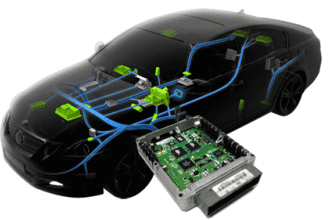The CAN Transport Protocol (CAN-TP) physical layer defines the hardware & electrical characteristics of the CAN protocol and specifies how data is transmitted over the physical medium. It includes specifications for voltage levels, signaling rates, wiring topology, and termination in a CAN network. In this article we will discuss about High-Speed CAN vs Low-Speed CAN vs Single Wire CAN bus.
There are several different CAN bus physical layers. Choosing the right CAN bus system is essential for ensuring optimal communication and performance in automotive networks. High-Speed CAN, Low-Speed CAN, and Single Wire CAN each offer distinct features and advantages tailored to different applications. In the following sections, we will delve into the specifics of each type, exploring their unique characteristics and ideal use cases in CAN bus protocol.
Table of Contents
High-Speed CAN bus
The most common type of CAN physical medium is High-Speed CAN, defined by the CAN standard ISO 11898-2.
High-speed CAN is a parallel, twisted, shielded, or unshielded pair of wires with differential voltage. It has a baud rate from 40 Kbits/sec to 1 Mbit/sec, depending on cable length. The two CAN wires are CAN_H (CAN_High) and CAN_L (CAN_Low). The maximum length of the stub must not exceed 30 cm for 500 bits/sec speed. For more extended wiring, a ground is included.
A high-speed CAN has to be terminated using 120 Ohm terminating resistors on both ends of the bus. This is to supply characteristic line impedance. CAN_H and CAN_L have differential voltage levels. The recessive level is 2.5 V on both CAN_H and CAN_L. Meanwhile, the dominant level is 3.5V for CAN_H and 1.5V for CAN_L. The differential Signal is Vdiff = CAN_H – CAN_L.
Gateways can connect ECUs in a system with both High-Speed CAN and Low-Speed CAN networks.
Low-Speed CAN bus
The ISO standard ISO 11898-3 defines another two-wire CAN physical medium for lower bus speeds: low-speed CAN. Low-Speed CAN is also known as Fault Tolerant CAN.
Low-speed CAN has a baud rate from 40 Kbits/sec to 125 Kbits/sec. The standard ISO 11898-3:2006 (low-speed, fault-tolerant (LSFT) medium-dependent interface) specifies a data rate between 40 kbit/sec and 125 bits/sec.
Unlike High-speed CAN, there is no termination on both ends of the bus in low-speed CAN. The low-speed CAN has to be terminated separately at every node. Different voltage levels on low-speed CAN are:
0.2V and 3.6V for CAN_H
1.8V and 4.8V for CAN_L
The main difference between High-Speed CAN and Low-Speed CAN is not the data rate but the voltage levels. Low-Speed CAN bus allows communication to continue in case of a wiring failure on the CAN bus lines due to its low data rate and high voltage range. Low-Speed CAN can operate despite the following malfunctions:
- Interruption of CAN_H and CAN_L.
- Shortcut between CAN_H or CAN_L and battery voltage.
- Shortcut between CAN_H or CAN_L and ground.
- Shortcut between CAN_H and CAN_L.
Single Wire CAN bus
Single-wire CAN (SWC), defined by SAE J2411, consists of an unshielded single wire as a physical connection between CAN nodes, with a voltage level related to the ground between 0V and 4.1V.
General Motors developed Single Wire CAN (SWC), also known as GMLAN, as an alternative to SAE J1850. GMLAN is primarily used in comfort electronics, such as central locking systems and power windows. The SWC transceiver connects directly to the battery voltage and includes termination on every transceiver.
In SWC, the data rate in normal mode for onboard communication is 33.33 bits/sec. The data rate in high-speed mode for diagnostic communication is 83.33 bits/sec. The maximum number of nodes in a network is 32. SWC has a selective sleep mode.
Final Thoughts
Understanding the distinctions between High-Speed CAN vs Low-Speed CAN vs Single Wire CAN bus systems is crucial for selecting the right communication protocol for specific applications.
High-Speed CAN offers superior data rates and reliability for critical systems, while Low-Speed CAN provides robust performance with fault tolerance, making it suitable for less demanding environments.
Single Wire CAN, with its simplicity & cost-effectiveness, serves niche applications where minimal wiring is advantageous.
By evaluating the unique features and advantages of each, engineers can optimize their network design to meet the requirements of modern automotive systems.







